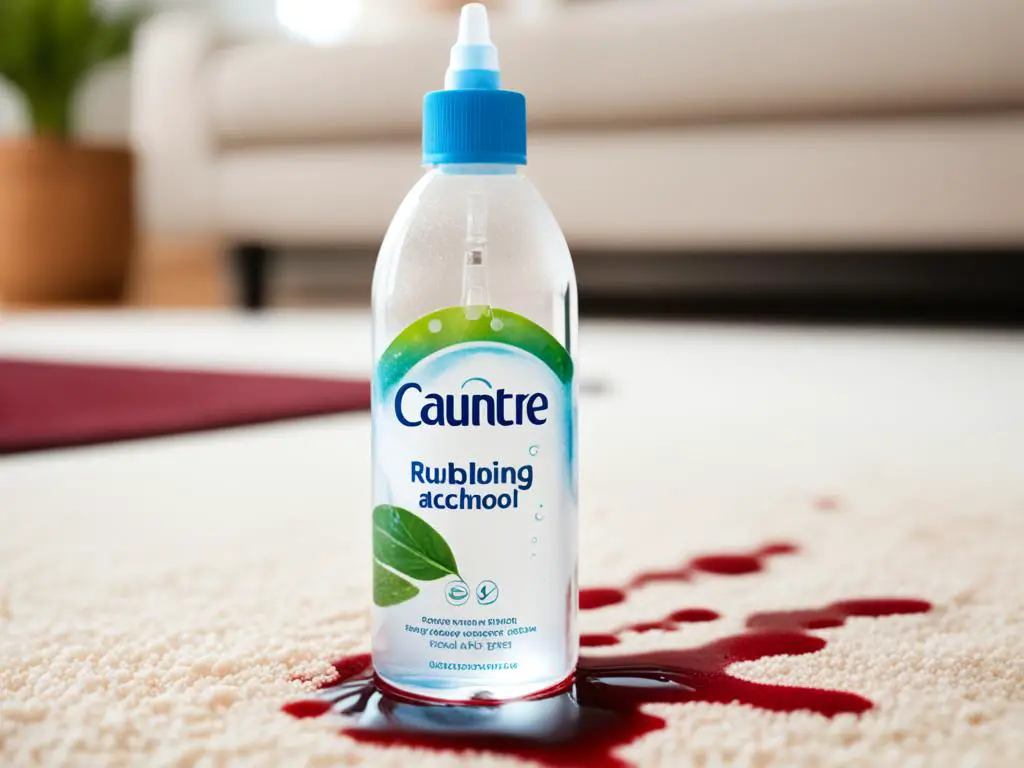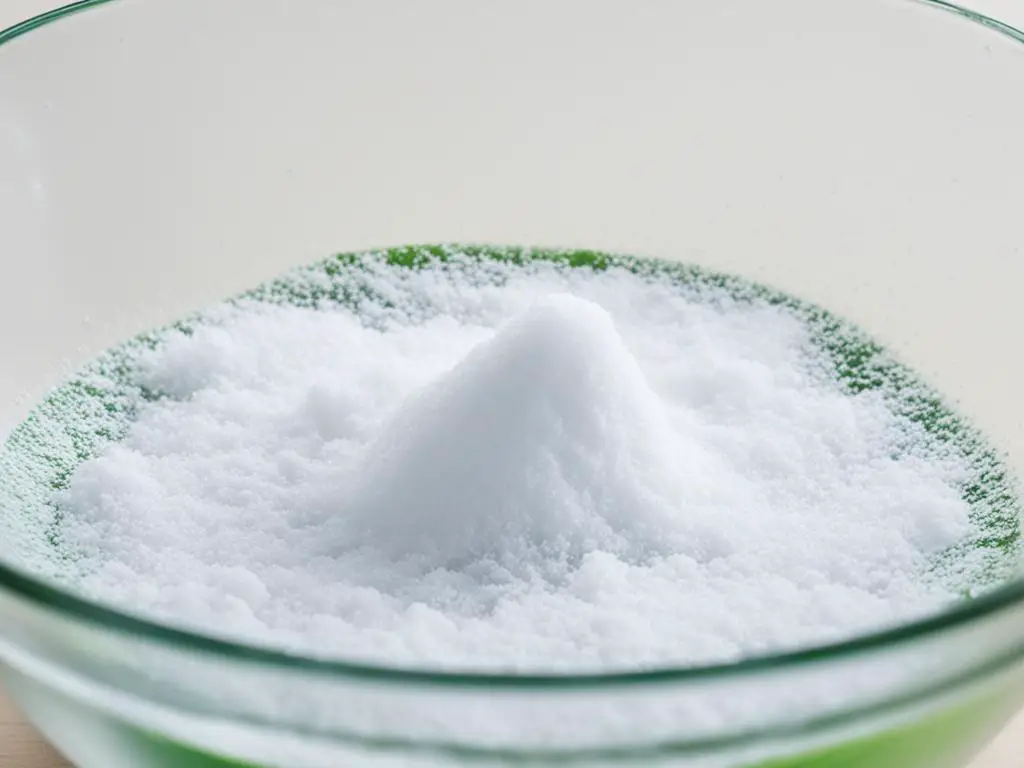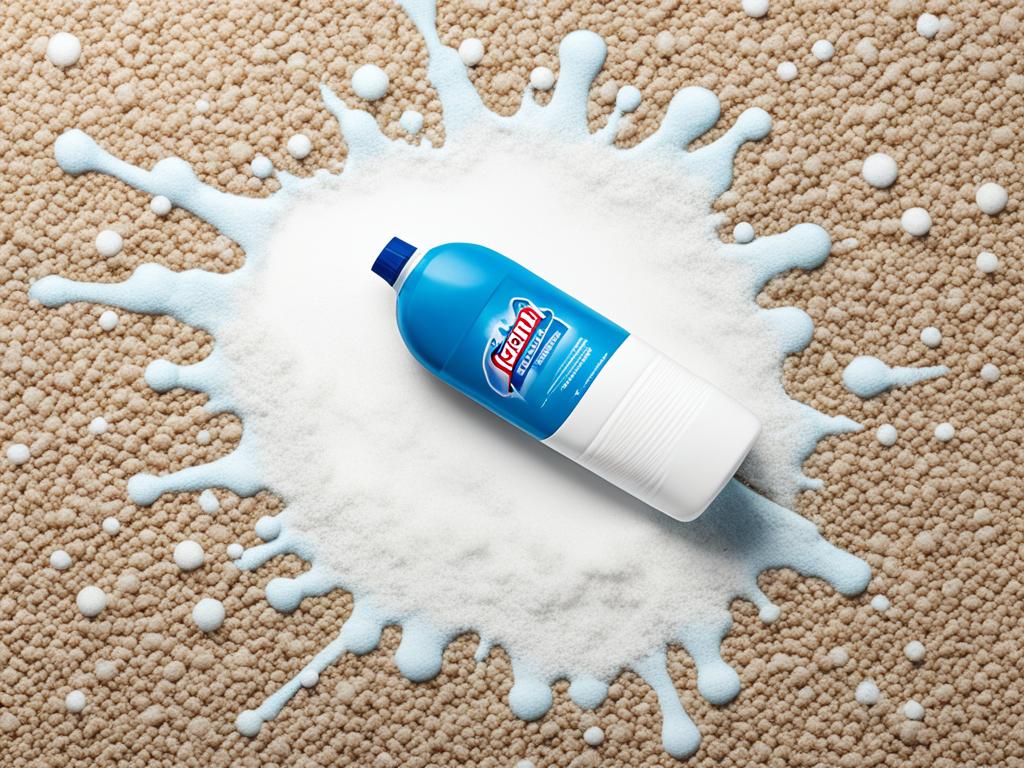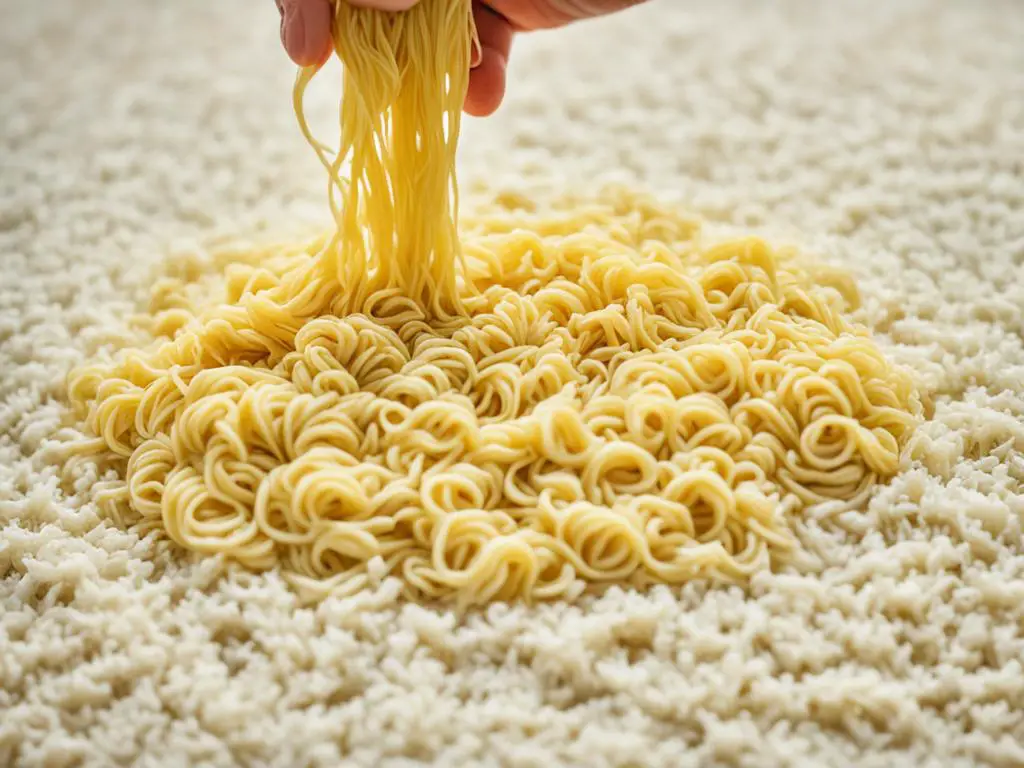Ramen noodles can leave stubborn stains on carpets if not cleaned properly. It’s important to take immediate action to prevent the stain from setting in. Dried ramen noodles can be difficult to remove as they break apart and their individual pieces become harder to clean. Ramen stains contain oils that make them almost impossible to remove with soap and water alone. Using water on a ramen stain can make it spread and create a bigger mess.
There are several methods for removing ramen stains from carpets, including using salt and white vinegar, rubbing alcohol, vinegar and baking soda, heavy-duty detergent, or stain remover. Each method has its own steps and can be effective depending on the freshness and severity of the stain.
Key Takeaways:
- Act quickly to prevent ramen stains from setting in.
- Dried ramen noodles can be difficult to remove, so it’s important to use the right cleaning method.
- Avoid using water on ramen stains as it can spread the stain and make it worse.
- Methods for removing ramen stains from carpets include salt and white vinegar, rubbing alcohol, vinegar and baking soda, heavy-duty detergent, or stain remover.
- Choose the method that best suits the freshness and severity of the stain.
Removing ramen stains from carpets requires the right technique and products. With the tips and methods provided, you can effectively eliminate ramen stains and keep your carpets clean and spotless.
Salt and White Vinegar Method for Ramen Stain Removal
If you find yourself dealing with a stubborn ramen stain on your carpet, don’t worry! There’s a simple and effective method using everyday household ingredients – salt and white vinegar.
The process is straightforward and requires just a few steps. Start by pouring a generous amount of salt directly onto the stain. Then, use a cloth or sponge to press the salt into the noodles, ensuring it penetrates into the fibers of the carpet.
Next, take some white vinegar and pour it over the salt-covered stain. Allow the vinegar and salt mixture to sit for a few minutes. The vinegar works to break down the oils in the ramen stain, making it easier to remove.
After the waiting period, take a clean cloth or sponge and blot the stained area. Gently press and lift the cloth or sponge onto the stain, absorbing the vinegar and salt mixture as you go. Repeat this blotting process until you notice the stain starting to fade.
Remember, it’s important to avoid scrubbing the stain vigorously, as it may damage the carpet fibers.
This salt and white vinegar method is particularly effective for fresh stains and can be a quick and efficient solution for your carpet cleaning needs.
To help you visualize the process, here’s a step-by-step breakdown:
- Pour salt onto the ramen stain, ensuring full coverage.
- Press the salt into the stain with a cloth or sponge.
- Pour white vinegar over the salt-covered stain.
- Allow the vinegar and salt mixture to sit for a few minutes.
- Blot the stain with a clean cloth or sponge, absorbing the vinegar and salt mixture.
- Repeat the blotting process until the stain fades.
By using the salt and white vinegar method, you can effectively remove ramen stains from your carpet and restore its pristine condition.
Rubbing Alcohol Method for Ramen Stain Removal
When it comes to removing stubborn ramen stains from carpets, one effective DIY method is using rubbing alcohol. This method is similar to the salt and white vinegar technique but utilizes the power of rubbing alcohol to tackle the stain.
To start, pour rubbing alcohol directly onto the ramen stain. Allow the rubbing alcohol to sit on the stain for several minutes. This helps to break down the oils and loosen the stain from the carpet fibers.
Next, take a clean cloth or sponge and gently blot the area. Be sure not to rub the stain, as this can cause it to spread and embed deeper into the carpet. Instead, focus on absorbing the rubbing alcohol and lifting the stain from the carpet.
Continue blotting until the ramen stain is no longer visible on the cloth or sponge. If needed, repeat the process with fresh rubbing alcohol until the stain is completely gone.

Using rubbing alcohol for ramen stain removal offers several benefits. First, it is a readily available household item, making it convenient for immediate stain treatment. Second, rubbing alcohol effectively cuts through the oils in the ramen stain, making it easier to remove. Lastly, this method is suitable for fresh stains, as the rubbing alcohol can penetrate the fibers quickly and break down the stain before it sets in.
It’s important to note that rubbing alcohol should be used with caution on carpets, as it may affect the carpet’s dye or finish. Test the rubbing alcohol on a small, inconspicuous area of the carpet first to ensure it doesn’t cause any damage. If the carpet reacts negatively to the rubbing alcohol, consider trying a different method for stain removal.
Pro Tip: Remember to always blot, not rub, when treating stains on carpets. Rubbing can push the stain further into the carpet fibers and make it more difficult to remove.
Vinegar and Baking Soda Method for Ramen Stain Removal
When it comes to tackling tough ramen stains on your carpet, the vinegar and baking soda method is a powerful solution. By combining these two household staples, you can create a potent stain removal paste that effectively eliminates stubborn stains.
To start, mix equal parts white vinegar and baking soda in a bowl to create a paste. The combination of these two ingredients forms a foamy reaction that helps to break down the stain and lift it from the carpet fibers.
Once you have your paste ready, apply it directly onto the ramen stain using a cloth or sponge. Gently scrub the paste into the stain, making sure to cover the entire affected area.
Allow the vinegar and baking soda paste to sit on the stain for about 10-15 minutes. This gives the mixture ample time to penetrate the stain and loosen its grip on the carpet fibers.
After the recommended time has passed, rinse the area with warm water to remove the paste and any residue left behind. Blot the dampened area with a clean cloth or towel to absorb excess moisture.
Finally, let the carpet air dry completely before walking on it or placing any furniture back in the area.
This vinegar and baking soda method is particularly effective for tackling tougher stains that may not have been fully removed by previous methods. The combination of these two ingredients helps to break down the stain components and neutralize odors.
Ramen Stain Removal – Vinegar and Baking Soda Method:
| Materials | Directions |
|---|---|
| White vinegar | Mix equal parts white vinegar and baking soda to create a paste. |
| Baking soda | Apply the paste onto the ramen stain using a cloth or sponge. |
| Cloth or sponge | Gently scrub the paste into the stain, covering the entire affected area. |
| Warm water | Let the paste sit on the stain for 10-15 minutes to allow it to penetrate. |
| Clean cloth or towel | Rinse the area with warm water and blot to absorb excess moisture. |
| Let the carpet air dry completely before using it. |
By following the vinegar and baking soda method, you can effectively remove tough ramen stains from your carpet, ensuring a clean and fresh-looking space.

Heavy-Duty Detergent and Stain Remover Methods for Ramen Stain Removal
If the previous methods fail to remove the ramen stain or if there is limited time, there are two additional methods to consider.
- Using Heavy-Duty Detergent: Mix heavy-duty detergent with water to create a foamy solution. Pour the solution over the stain and let it sit for five minutes. Blot the area with a cloth or paper towels to remove the stain. This method is effective and requires minimal effort.
- Using Stain Remover: Apply a carpet-specific stain remover to a damp cloth or sponge. Rub the stain remover onto the ramen stain until it disappears. Blot any excess liquid with a clean cloth or paper towel and allow the area to air dry. Vacuum the carpet once it’s fully dry. This method provides a convenient solution for removing tough ramen stains.
These methods offer alternative options for effectively removing ramen stains from your carpet.

Conclusion
Removing ramen stains from carpets can be a daunting task, but with the right methods and products, you can restore your carpet to its original spotless and clean condition. Whether you prefer using natural ingredients like salt and white vinegar, or household items like rubbing alcohol, vinegar and baking soda, heavy-duty detergent, or stain remover, there are plenty of DIY carpet cleaning options to choose from.
Remember, timing is crucial when dealing with ramen stains. It’s important to take immediate action to prevent the stain from setting in. By following the appropriate method depending on the freshness and severity of the stain, you can effectively tackle the stubborn ramen stains and avoid any long-term damage to your carpet.
So the next time you spill ramen on your carpet, don’t panic. Instead, grab the necessary ingredients and get to work. With some carpet cleaning tips and a little effort, you’ll be able to remove those pesky ramen stains and enjoy a clean and fresh carpet once again.



